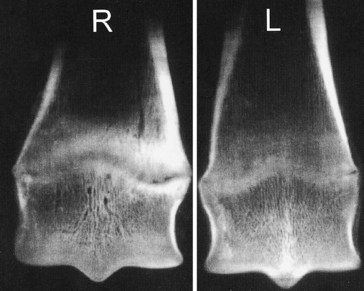Chapter 57Physitis
Pathogenesis
I consider the pathogenesis of physitis to be consistent with a type V Salter-Harris growth plate injury. This implies a compression lesion that arises medially as a consequence of the greater weight being borne on the medial aspect of the forelimb. Although the medial aspect of the forelimb is the most frequent site, physitis also occurs laterally in a foal with a carpal valgus deformity. Physitis arises at a time in the most active growing phases of young horses, when endochondral ossification is at its peak in the affected physis. It also occurs in the contralateral limb after a chronic lameness, at the fetlock in a younger foal, or at the carpus in older foals and yearlings. For example, I have encountered physitis in the contralateral forelimbs of foals with severe acquired flexural deformity of the distal interphalangeal joint (Figure 57-1). Although physitis may result in an upright conformation of the fetlock joint, probably from off-loading the limb to relieve pain, physitis does not cause other flexural deformity.




